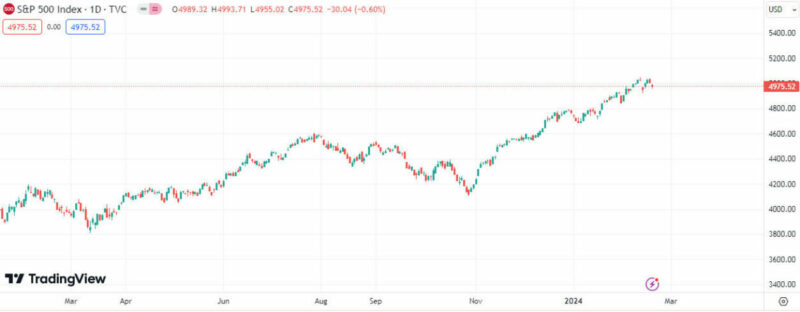This week, Goldman Sachs analysts adjusted their year-end S&P 500 index target upward to 5,200 points from the previous 5,100. The revised target represents approximately a 4.5% increase over current levels and it is important to mention that David Kostin, Goldman Sachs’ chief U.S. equity strategist, attributed the target adjustment to higher profit estimates. David Kostin, Goldman Sachs’ chief U.S. equity strategist, said:
“Our upgraded 2024 EPS forecast of $241 (8% growth) stands above the median top-down strategist forecast of $235 (6% growth) and reflects our expectation for stronger economic growth and higher profits for the Information Technology and Communication Services sectors, which contain 5 of the “Magnificent 7” stocks.”
Higher profit estimates suggest that companies are expected to generate stronger earnings in the future. Since stock prices are often influenced by expectations of future earnings, an anticipated increase in profitability can lead to higher valuations for stocks in the index.
See Related: Bitcoin and Ethereum Technical Analysis
Future Performance Of The S&P 500 Index
Positive profit revisions provide a fundamental basis for optimism about the future performance of the S&P 500 index and this can certainly boost investor confidence in the broader market outlook. Nevertheless, the three major indexes on Wall Street started the week with declines, as persistent inflation took the spotlight amid mixed earnings from two prominent retailers (Walmart and Home Depot).

Additionally, concerns lingered among investors regarding the potential for sustained higher interest rates, fueled by last week’s data. Sam Stovall, CFRA’s chief investment strategist, cautioned investors who viewed the current equity dip as a buying opportunity, stating that the persistence of inflation is likely to prompt the Federal Reserve to proceed more cautiously in reducing its key short-term interest rate.
Some Fed officials also expressed caution about inflation and Atlanta Fed President Raphael Bostic said he needed more evidence inflation pressures are easing. San Francisco Fed President Mary Daly said “There is more work to do” to ensure stable prices, despite remarkable progress.
At the same time, the escalation of geopolitical uncertainties introduces an additional challenge and heightens the potential for unforeseen risks in both markets and economic performance. Considering all of these factors, the perspective is likely to stay cautious as long as interest rates remain significantly restrictive and the looming presence of geopolitical risks persists.



